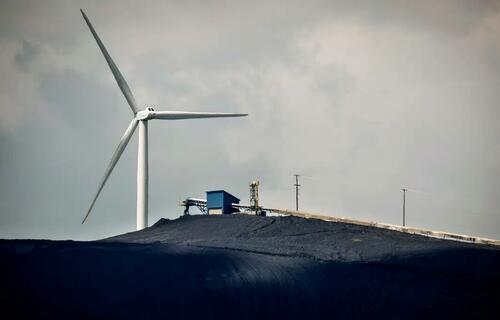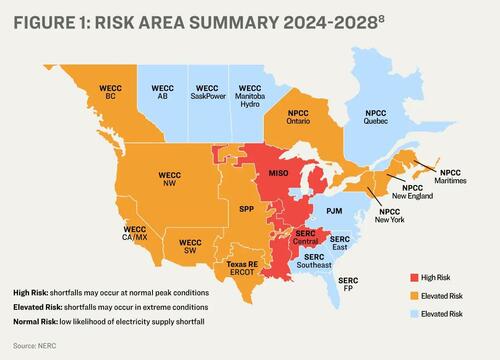Authored by Kevin Stocklin via The Epoch Times (emphasis ours),
As the Biden administration promises to eliminate coal power throughout the United States, energy experts are sounding the alarm about what will be left of U.S. energy infrastructure if these plans succeed.

U.S. climate envoy John Kerry said on Dec. 2 at the U.N. COP 28 global warming summit that the Biden administration “will be working to accelerate unabated coal phase-out across the world, building stronger economies and more resilient communities.”
President Joe Biden said recently of coal plants, “We’re going to be shutting these plants down all across America and having wind and solar power.”
To achieve its net-zero goals, the Biden administration has leveraged the Environmental Protection Agency (EPA) and its authority under the 1970 Clean Air Act to launch a fundamental restructuring of the U.S. electricity infrastructure.
In May, the EPA proposed new rules that set much stricter limits on carbon dioxide (CO2) emissions from coal and natural gas plants.
“EPA projects these proposals would cut 617 million metric tons of CO2 through 2042 along with tens of thousands of tons of ... harmful air pollutants that are known to endanger public health,” the EPA stated.
Despite the unambiguous statements from the Biden administration that it's ending coal production in the United States, supporters of the EPA’s new rules insist that coal plants will be able to comply and continue to operate.

“This is ultimately a modest rule that builds upon the Inflation Reduction Act, which will further support cost-effective compliance with the proposed standards,” he said. “This proposal provides ample flexibility to entities [to comply]."
However, critics of the EPA’s new rules say limits are set so tight that coal plants will be forced to close.
“It’s death by a thousand paper cuts,” Michael Nasi, an environmental attorney who provided testimony at the congressional hearing, told The Epoch Times. “They're putting out a slew of regs that are intended to basically eviscerate the remaining coal fleet.
A turbine from the Roth Rock wind farm spins over the ridge of Backbone Mountain behind the Mettiki Coal processing plant in Oakland, Md., on Aug. 23, 2022. (Chip Somodevilla/Getty Images)
“This rule is not happening in isolation. We have three or four other major environmental rules that EPA is chasing.”
They include the EPA’s ozone transport or “good neighbor” rule, a Mercury and Air Toxics Standards rule, Regional Haze programs, and others.
The net result is that many coal plants are simply surrendering and shutting down well before the end of their productive life. This includes the newer plants, which are among the cleanest-burning coal plants in the world.
“Everything that’s left in the U.S. fleet is not a bunch of dirty old coal plants; these are the plants that made the retrofits necessary to extend their lives,” Mr. Nasi said. “They are the newer plants, the ones that actually were so vital that more investment was made.”
A 2020 report by the U.S. Department of Energy states that “coal-fired electricity generation is cleaner than ever."
The report cites research by the National Energy Technology Laboratory that shows "a new coal plant with pollution controls reduces nitrogen oxides by 83 percent, sulfur dioxide by 98 percent, and particulate matter by 99.8 percent compared to plants without controls.”

Mr. Nasi said that's what makes the EPA's added regulations "even more offensive."
"These units all made investments on the assumption that the EPA would stay within the Clear Air Act and that once they made those changes, they would be deemed to be in compliance,” he said.
“These coal plants acted in good faith ... and now they’re being told that’s not good enough, and here’s some new regulations that you will not be able to comply with.
“What the EPA is doing is going well beyond the letter and intent of the law on several different pollutants, and carbon is, of course, the biggest of them all.”
Despite the coal industry’s progress in reducing pollution, the only solution that global warming activists appear willing to accept is the abolition of coal.
A report by ODI, a proponent of wind and solar energy formerly known as the Overseas Development Institute, concedes that the thermal efficiency of burning coal to make electricity has increased to 50 percent from 30 percent, with the result being that 40 percent less CO2 is produced.
“This is impressive, but it’s not enough,” the ODI stated. “Even the most advanced coal plant produces around 30 times more CO2 than wind and hydro, 20 times more than solar and geothermal, and 50 percent more than natural gas.”

'Largely Uninvestable'
Global banks and asset managers have joined the fight against coal, working within the environmental, social, and governance (ESG) movement to cut off financing for the coal industry.
According to a report by InfluenceMap, a data analytics firm, more than 500 investment managers, with $1.4 trillion in assets under management, pledged to divest from coal, making coal plants “largely uninvestable.”
A report in May by the Institute for Energy Economics and Financial Analysis listed more than 200 international banks, insurance companies, export credit agencies, and development banks that are divesting from coal. The companies include global powerhouses such as AIG, Allianz, AXA, Bank of America, Barclays, BlackRock, Citibank, Fidelity, Goldman Sachs, JPMorgan Chase, and UBS.
Caught between the Biden administration and Wall Street, the U.S. coal industry is withering.
Nearly 13 gigawatts of coal generation capacity was shut down in 2022—double the amount of production that was shuttered in 2021, according to the American Public Power Association.
An additional 41 gigawatts of coal capacity is scheduled to be shut down by 2027.
Overall, 83 gigawatts of coal, gas, and nuclear power generation are scheduled to be shut down over the next decade as the United States embarks on what President Biden calls the “incredible transition” to wind and solar energy.
The United States currently has approximately 1.3 terawatts of electricity generation capacity in total.
Shutting Down Faster Than Replacing
Energy experts are sounding the alarm about the dangers of this transition, warning that the U.S. electric grid is becoming increasingly unstable as a result.
The North American Electric Reliability Corp. (NERC), an organization charged with monitoring the reliability of the U.S. grid, stated in its December report that there's “clear evidence of growing resource adequacy concerns over the next 10 years,” because coal and gas plants are being eliminated faster than new capacity is being added.
The NERC’s risk assessment identifies a broad segment of the central United States, from Minnesota to Louisiana, as “high risk,” meaning that blackouts can occur under normal conditions.
All of the states to the west of this area, as well as all of the northeastern U.S. states, are identified as “elevated risk,” meaning that electricity shortages can occur during times of very high or low temperatures.
Read more here...
